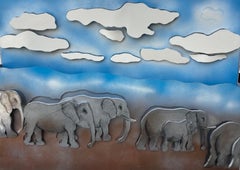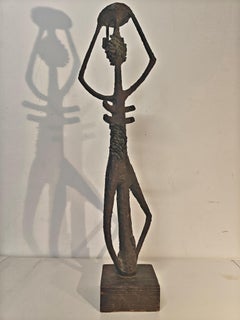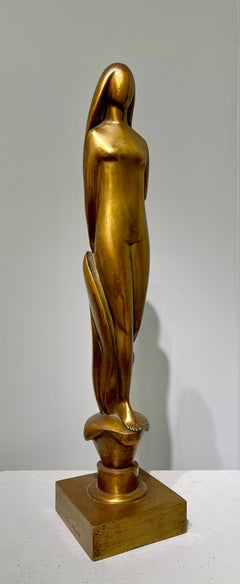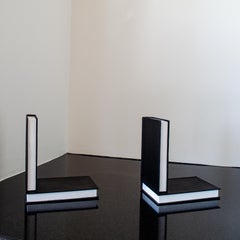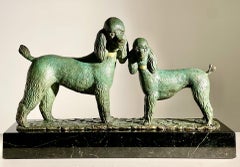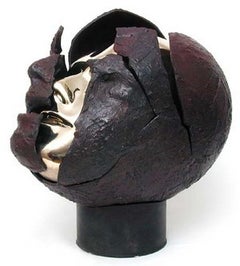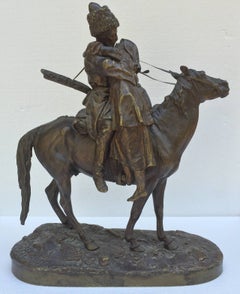Lincoln Glenn Figurative Sculptures
to
2
5
1
2
2
3
Overall Width
to
Overall Height
to
2
10
1
2
2
1
3
1
1
2
1
1
1
1
5
4
3
3
2
1
1
1
1
1
1
1
1
1
1
1
1
1
11
8
6
2
2
2
1
1
1
1
13
"Amboseli Elephants" Larry Rivers, Pop Art Sculpture, Blue Sky, Animal Herd
By Larry Rivers
Located in New York, NY
Larry Rivers
Amboseli Elephants, 1968
Metal with airbrushing, acrylic
26 x 36 x 5 1/4 inches
Provenance
Private Collection, New York. C. 1970
Estate of the above, 2025
Born in Aug...
Category
1960s Pop Art Figurative Sculptures
Materials
Metal
"Untitled" David Hare, Surrealist, Anthropomorphic, Modernist, Ab-Ex Sculpture
By David Hare
Located in New York, NY
David Hare
Untitled, circa 1949
Bronze
25 x 8 x 7 inches
Provenance
Kootz Gallery, New York
Collection of Samuel Kootz New York
Estate of the above
Collection of Dr. Joyce Kootz, Ne...
Category
1940s Surrealist Abstract Sculptures
Materials
Bronze
"Young Woman Nude" Warren Wheelock, Art Deco, Modernist Female Sculpture Form
By Warren Wheelock
Located in New York, NY
Warren Wheelock
Untitled (Young Woman Nude), 1924
Incised signature and date to edge of base "© 1924 by Warren Wheelock"
Bronze
Sculpture: 20 h × 4½ w...
Category
1920s Art Deco Figurative Sculptures
Materials
Bronze
"Untitled (Bookends)" Steven Wolfe, Illusionistic Book Sculpture, Trompe-l'oeil
Located in New York, NY
Steven Wolfe
Untitled (Bookends), 1990
Stamped: SW 1990 2/3
Painted Bronze
6 1/4 x 7 x 4 inches
Edition 2/3
Steven Wolfe crafted sculptures and drawings of remarkable skill and vis...
Category
1990s Contemporary Figurative Sculptures
Materials
Bronze
"Monument 8" Calvin Marcus, Mixed Media Construction Contemporary Sculpture
Located in New York, NY
Calvin Marcus
Monument 8, 2018
Wood, glass, hot glue, cardboard, plastic, paper pulp, sulfur, ash, gesso, Cel-Vinyl, flashe, watercolor and other media sculpture
22" high x 13 1/4" w...
Category
2010s Contemporary Figurative Sculptures
Materials
Glass, Plastic, Wood, Paper, Glue, Mixed Media, Watercolor, Cardboard
$9,600 Sale Price
20% Off
"Poodles: Nora and Sheila" Herbert Haseltine, Bronze Dogs Animals Sculpture
Located in New York, NY
Herbert Haseltine
Poodles: Nora and Sheila, 1944, cast 1945
Signed and dated on base
Bronze with green patina
11 inches high x 17 inches wide x 6 inc...
Category
1940s Realist Figurative Sculptures
Materials
Bronze
"Jules Bastien LePage" Augustus Saint-Gaudens, Bas Relief of French Painter
By Augustus Saint-Gaudens
Located in New York, NY
Augustus Saint-Gaudens
Jules Bastien LePage
Bronze
14 1/4 x 10 1/8 inches
Augustus Saint-Gaudens was born in 1848 in Dublin, Ireland. His father, Bern...
Category
1880s Realist Figurative Sculptures
Materials
Bronze
"Sudbourne Premier: Suffolk Punch Stallion" Herbert Haseltine, 1927 Bronze
Located in New York, NY
Herbert Haseltine
Sudbourne Premier: Suffolk Punch Stallion, 1927
Signed left side: © HASELTINE / MCMXXVII
Bronze, dark brown patina, parcel gilding
...
Category
1920s Realist Figurative Sculptures
Materials
Bronze
"Reclining Woman" Karl Bitter, Reclining Woman with Reddish Patina
Located in New York, NY
Karl Bitter
Reclining Woman, 1897
Signed: Bitter 97
Stamped: GORHAM M F G CO.
Bronze
10.25 x 10.25 x 4 inches
Initially from Vienna, Karl Bitter first studied art at the city’s Kunstgewerbeschule and the Kunstakademie before being drafted into the Austrian army. He deserted his position in the military while on leave, and departed for New York City where he would discover considerable success. Early on, he won a competition for the Astor memorial bronze gates at Trinity Church, which awarded him enough capital to open his own studio. He went on to execute sculptures of Alexander Hamilton and Thomas Jefferson at the Cuyahoga Courthouse in Cleveland; he also created portraits of Jefferson for the state of Missouri and the University of Virginia. These commissions caught the attention of sculptor Richard Morris Hunt (who famously designed the façade of the Metropolitan Museum), earning Bitter the duty of producing the portrait medallions that now appear near the top of the museum’s grand face.
Notably, he presented at Chicago’s 1893 World’s Columbian Exposition and directed the Pan-American Exposition in Buffalo in 1901. Over his career, his artwork became more flexible – his early academy training is easily identifiable within his work, but after moving to America, conventions of Modernism became more prevalent within his sculpture. In addition to many awards, Bitter presided over the National Sculpture Society in 1906-1907, and was a member of the National Institute of Arts and Sciences, the National Academy of Design, the American Academy of Arts and Letters, the Architectural League, and the Art Commission, New York. His public work can be found at the Biltmore Estate, Asheville, NC; Gettysburg National Military Park, Gettysburg, PA; Wisconsin State Capitol, Madison, WI; United States Naval Academy...
Category
1890s Realist Figurative Sculptures
Materials
Bronze
"Dancer" David Hare, Male Nude, Figurative Sculpture, Mid-Century Surrealist
By David Hare
Located in New York, NY
David Hare
Dancer, circa 1955
Bronze with integral stand
68 high x 17 wide x 13 1/2 deep inches
“Freedom is what we want,” David Hare boldly stated in 1965, but then he added the caveat, “and what we are most afraid of.” No one could accuse David Hare of possessing such fear. Blithely unconcerned with the critics’ judgments, Hare flitted through most of the major art developments of the mid-twentieth century in the United States. He changed mediums several times; just when his fame as a sculptor had reached its apogee about 1960, he switched over to painting. Yet he remained attached to surrealism long after it had fallen out of official favor. “I can’t change what I do in order to fit what would make me popular,” he said. “Not because of moral reasons, but just because I can’t do it; I’m not interested in it.”
Hare was born in New York City in 1917; his family was both wealthy and familiar with the world of modern art. Meredith (1870-1932), his father, was a prominent corporate attorney. His mother, Elizabeth Sage Goodwin (1878-1948) was an art collector, a financial backer of the 1913 Armory Show, and a friend of artists such as Constantin Brancusi, Walt Kuhn, and Marcel Duchamp.
In the 1920s, the entire family moved to Santa Fe, New Mexico and later to Colorado Springs, in the hope that the change in altitude and climate would help to heal Meredith’s tuberculosis. In Colorado Springs, Elizabeth founded the Fountain Valley School where David attended high school after his father died in 1932. In the western United States, Hare developed a fascination for kachina dolls and other aspects of Native American culture that would become a recurring source of inspiration in his career.
After high school, Hare briefly attended Bard College (1936-37) in Annandale-on-Hudson. At a loss as to what to do next, he parlayed his mother’s contacts into opening a commercial photography studio and began dabbling in color photography, still a rarity at the time [Kodachrome was introduced in 1935]. At age 22, Hare had his first solo exhibition at Walker Gallery in New York City; his 30 color photographs included one of President Franklin Roosevelt.
As a photographer, Hare experimented with an automatist technique called “heatage” (or “melted negatives”) in which he heated the negative in order to distort the image. Hare described them as “antagonisms of matter.” The final products were usually abstractions tending towards surrealism and similar to processes used by Man Ray, Raoul Ubac, and Wolfgang Paalen.
In 1940, Hare moved to Roxbury, CT, where he fraternized with neighboring artists such as Alexander Calder and Arshile Gorky, as well as Yves Tanguy who was married to Hare’s cousin Kay Sage, and the art dealer Julian Levy. The same year, Hare received a commission from the American Museum of Natural History to document the Pueblo Indians. He traveled to Santa Fe and, for several months, he took portrait photographs of members of the Hopi, Navajo, and Zuni tribes that were published in book form in 1941.
World War II turned Hare’s life upside down. He became a conduit in the exchange of artistic and intellectual ideas between U.S. artists and the surrealist émigrés fleeing Europe. In 1942, Hare befriended Andre Breton, the principal theorist of surrealism. When Breton wanted to publish a magazine to promote the movement in the United States, he could not serve as an editor because he was a foreign national. Instead, Breton selected Hare to edit the journal, entitled VVV [shorth for “Victory, Victory, Victory”], which ran for four issues (the second and third issues were printed as a single volume) from June 1942 to February 1944. Each edition of VVV focused on “poetry, plastic arts, anthropology, sociology, (and) psychology,” and was extensively illustrated by surrealist artists including Giorgio de Chirico, Roberto Matta, and Yves Tanguy; Max Ernst and Marcel Duchamp served as editorial advisors.
At the suggestion of Jacqueline Lamba...
Category
1950s Abstract Figurative Sculptures
Materials
Bronze
$20,000 Sale Price
20% Off
"Hitch Hiked" Hayward Oubre, Painted Wire Sculpture, Southern Black Artist
Located in New York, NY
Hayward Oubre
Hitch Hiked, 1960
Signed on Base: OUBRE 60
Painted wire sculpture
45 H. x 21 W. x 19 D. inches
Provenance:
Estate of the Artist
Deeply at...
Category
1960s Figurative Sculptures
Materials
Wire
"The Trap" Hayward Oubre, Painted Wire Sculpture, Black Artist
Located in New York, NY
Hayward Oubre
The Trap, c. 1960
Painted wire sculpture
40 H. x 16 1/2 W. x 21 D. inches
Provenance:
Estate of the Artist
Deeply attached to his Souther...
Category
1960s Figurative Sculptures
Materials
Wire
"Tropical Parrot with Woman, " Corneille, Carved Wood Sculpture with Bird
By Corneille
Located in New York, NY
Guillaume Cornelis van Beverloo (Corneille)
Tropical Parrot with Woman, circa 1970
Signed: Corneille
Edition Number: 6 of 8
Constructed and Painted wood
39" high x 40 1/2" wide x 6" ...
Category
1970s Figurative Sculptures
Materials
Wood, Paint
Related Items
Tabula Rasa - abstracted, gothic, bronze, gold plated, figurative sculpture
By Dale Dunning
Located in Bloomfield, ON
A gold patinated head bursts from its shell of bronze in this aptly titled sculpture by Dale Dunning.
Bronze sculptor Dale Dunning’s skilled craftsmanship never overshadows the stor...
Category
2010s Contemporary Figurative Sculptures
Materials
Bronze
$14,500
H 16 in W 16 in D 11 in
"The Farewell Kiss"
By Evgeny Lanceray
Located in Southampton, NY
This is a beautiful original bronze casting by the foremost Russian sculptor of his day Evgeny Lanceray. Artist signed on the base in Cyrillic (image 5) and is also inscribed on the ...
Category
Late 19th Century Realist Figurative Sculptures
Materials
Bronze
Juggler / - Artistic naturalness -
Located in Berlin, DE
Claire Jeanne Robertine Colinet (1880 Brussels - 1950 Asnières-sur-Seine), Juggler, around 1920. Brownish patinated bronze with gilded balls on a round, multi-profiled stone base (10...
Category
1920s Art Deco Nude Sculptures
Materials
Bronze
$3,428
H 18.51 in W 7.88 in D 9.85 in
Javelin thrower / - Roman present -
By Franz Iffland
Located in Berlin, DE
Franz Iffland (1862 Tempelhof - 1935 Berlin), Javelin thrower, after 1910. Olive-black patinated bronze with cast plinth mounted on a white-veined black marble base (7 cm high). Tota...
Category
1910s Art Deco Nude Sculptures
Materials
Bronze
$2,364 Sale Price
20% Off
H 24.02 in W 10.24 in D 9.85 in
"XMITTER" Helmet & Jacket Sculpture
Located in Chicago, IL
To Chicago-based artist Patrick Fitzgerald, his sculptures are a means of traveling through time. Working from found materials, Fitzgerald constructs miniature soap box cars...
Category
21st Century and Contemporary Outsider Art Figurative Sculptures
Materials
Wire
PRINCE BLAZE (The Official Dragon Prince Of 2024: The Year Of The Dragon)
By Mauro Oliveira
Located in LOS ANGELES, CA
*New Year Inventory Renewal Sale - 90 Days Until April 30th*
*This Price Won't Be Repeated Again This Year*
Absolutely and positively one of a kind Dragon Sculpture Masterpi...
Category
21st Century and Contemporary Pop Art Figurative Sculptures
Materials
Metal
$28,000 Sale Price
20% Off
H 57 in W 36 in D 45 in
HER MAJESTY QUEEN ELIZABETH II (1 of a kind Swarovski Skull w/ Base and Crown).
By Mauro Oliveira
Located in LOS ANGELES, CA
*New Year Inventory Renewal Sale - 90 Days Until April 30th*
*This Price Won't Be Repeated Again This Year*
**This is absolutely and positively ONE OF A KIND on planet Earth...
Category
21st Century and Contemporary Pop Art Figurative Sculptures
Materials
Metal
$12,000 Sale Price
20% Off
H 18 in W 12 in D 14 in
Late 19th Century Pair of Bronze Atlas Sculptures with Globe & Armillary Sphere
Located in Fredericksburg, VA
This pair of bronze sculptures of Atlas with Globe & Armillary Sphere are of high cast quality. Pairs have sold for over 700,000 Euro. Their condition is excellent for age and has ve...
Category
Early 20th Century Art Deco Nude Sculptures
Materials
Bronze
$395,000
H 89 in W 22 in
Davinci's Horse Rears by Helle Crawford, Bronze sculpture of a horse
By Helle Rask Crawford
Located in DE
Bronze sculpture of a horse that rears on granite base
Category
21st Century and Contemporary Contemporary Figurative Sculptures
Materials
Granite, Bronze
$1,052
H 8.67 in W 5.52 in D 2.37 in
Gymnast (bust), Bronze Sculpture
By Richard MacDonald
Located in Aventura, FL
Bronze sculpture with marble base. Incised artist signature and date. Sculpture size 13.5 x 7 x 6 inches (including base). Sculpture is in excellent condition (marble base has a c...
Category
1980s Surrealist Figurative Sculptures
Materials
Bronze
$4,875 Sale Price
25% Off
H 13.5 in W 7 in D 6 in
Distributeur Pez Mickey Tribute
Located in PARIS, FR
Annick b. Cuadrado, a French artist, born and working in Paris, introduces in her works of art the most famous products of our consumer life. She has convinced the owners of the most...
Category
21st Century and Contemporary Pop Art Figurative Sculptures
Materials
Plexiglass, Acrylic
Large Metal Sculpture Wall Hanging 3D Painting New York City Whimsical Pop Art
By Yuval Mahler
Located in Surfside, FL
Large painted metal wall hanging sculpture by Yuval Mahler (Israeli, b. 1951). Hand signed "Y. Mahler" recto. (it is not numbered or editioned and might be unique). it is done in a g...
Category
21st Century and Contemporary Pop Art Figurative Paintings
Materials
Metal
$3,600
H 43 in W 41 in D 3 in
